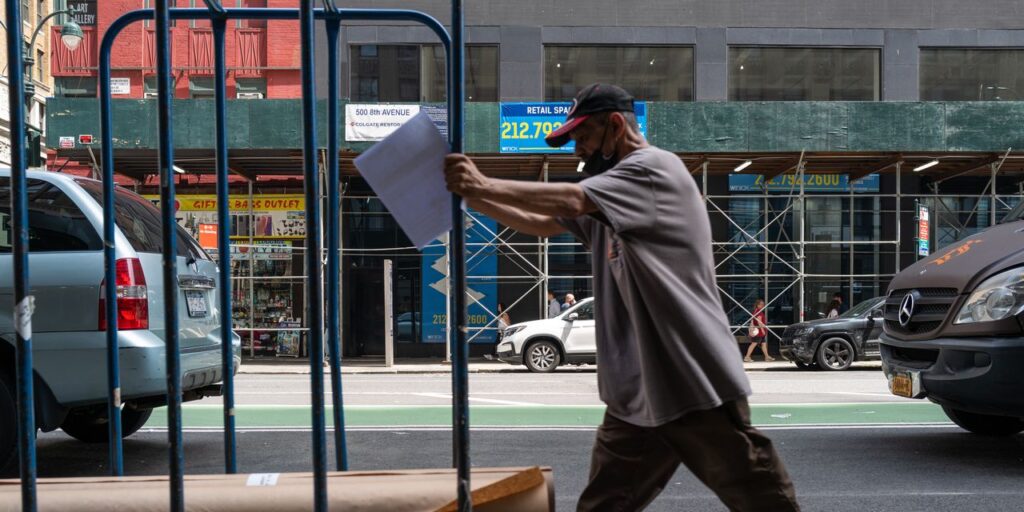The U.S. economy has not only defied widespread predictions of a sharp slowdown. It’s grown even faster.
But that doesn’t mean a recession is far away. The U.S. has often experienced fast growth shortly before the bottom fell out.
Let’s start with the good news.
Gross domestic product, the official scorecard of the economy, looks likely to top 4% or even 5% annual growth in the third quarter. The government will release its preliminary estimate on Thursday morning.
Economists polled by The Wall Street Journal predict 4.7% GDP in the third quarter.
Other top forecasters see even faster growth. S&P Global estimates 5.6% GDP and the Atlanta Federal Reserve GDPNow forecast projects 5.4%.
How fast is that? GDP only topped 5% once from 2010 to the start of the pandemic in early 2020.
This is not what was supposed to happen.
After solid 2%-plus growth in the first and second quarters, the economy was widely expected to slow down in response to rapidly rising interest rates.
The Federal Reserve has jacked up borrowing costs in the past year and a half to try to tame inflation, a strategy that typical depresses consumer spending and business investment. Those are the dual engines of the economy.
To some extent the Fed has succeeded. Home sales and construction, for instance, have tumbled due to the highest mortgage rates in decades. And manufacturers have taken a hit as customers curtailed purchases of goods and big-ticket items.
The annual rate of inflation, meanwhile, has tapered to 3.7% as of September from a 40-year high of 9.1% in 2022.
Still, spending and investment have not dropped off nearly as much as expected. And there are two reasons for that.
The first is a strong and ultra-tight labor market, with unemployment hovering just below 4%. Most Americans who want a job have one, and as a result, they have been able to keep spending. Travel, recreation, leisure and hospitality have been the big winners.
S&P Global estimates a flush of consumer spending in the third quarter will account for just over half of the growth.
The industrial side of the economy, for its part, has been the beneficiary of tens of billions of dollars in subsidies from the Biden administration to support green energy and bring home more manufacturing.
The U.S. has also ramped up military aid to Ukraine and has to replace outgoing equipment, weapons and ammunition.
All the government money has helped to keep manufacturers from falling too far down the well. Government outlays could add as much as 0.6 percentage points to third-quarter GDP.
Making the third quarter look even better, the U.S. trade deficit fell sharply and is likely to add 1.0 percentage point or more to GDP.
A small rebound in the production of inventories, or unsold goods, would be the icing on the cake.
So the economy is doing great, right? Maybe not.
Consumers probably can’t keep spending at their current pace since their incomes are barely rising faster than inflation. Businesses are proceeding cautiously because of higher borrowing costs. And banks are more reluctance to lend.
Other restraints on the economy include higher gasoline prices and a surge in long-term interest rates that make it far more expensive to buy houses, cars, appliances and the like.
That’s why many forecasters believe the economy start to soften in final months of 2023. S&P Global, for instance, initially projects 1.7% growth in the fourth quarter.
Nor does the third quarter’s heady growth rate suggest there is no reason to worry about a recession. The economy has expanded rapidly just before the onset of prior recessions.
The economy grew at solid 2.5% pace right before the 2007-2009 Great Recession, for example. And GDP grew a frothy 4.4% in the first quarter of 1990 just several months before a recession started.
Many of the same economic headwinds, it turns out, are still in place that led to widespread Wall Street predictions of recession earlier in the year.
Indeed, some forecasters such as the Conference Board still insist a short recession is likely in 2024. Other economists are also on guard.
“I still believe a recession is coming — though far less severe than the 2008-2009 event,” said chief economist Steve Blitz of TS Lombard.
Read the full article here











